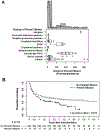Incidence, etiology, and outcome of pleural effusions in allogeneic hematopoietic stem cell transplantation
- PMID: 27238902
- PMCID: PMC6852667
- DOI: 10.1002/ajh.24435
Incidence, etiology, and outcome of pleural effusions in allogeneic hematopoietic stem cell transplantation
Abstract
Pleural effusion is a known entity in patients undergoing allogeneic hematopoietic stem cell transplantation (HSCT); however, the incidence, risk factors, and morbidity-mortality outcomes associated with pleural effusions remain unknown. We retrospectively evaluated pleural effusions in 618 consecutive adult patients who underwent allogeneic HSCT from January 2008 to December 2013 at our institution. Seventy one patients developed pleural effusion at a median of 40 days (range, 1 - 869) post-HSCT with the cumulative incidence of 9.9% (95% CI, 7.7 - 12.5%) at 1 year. Infectious etiology was commonly associated with pleural effusions followed by volume overload and serositis type chronic GVHD. In multivariate analysis, higher comorbidity index (P = 0.03) and active GVHD (P = 0.018) were found to be significant independent predictors for pleural effusion development. Higher comorbidity index, very high disease risk index, ≤7/8 HLA matching, and unrelated donor were associated with inferior overall survival (OS) (P < 0.03). More importantly, patients with pleural effusion were noted to have poor OS in comparison to patients without pleural effusion (P < 0.001). Overall, pleural effusion is a frequently occurring complication after allogeneic HSCT, adding to morbidity and mortality and hence, early identification is required. Am. J. Hematol. 91:E341-E347, 2016. © 2016 Wiley Periodicals, Inc.
© 2016 Wiley Periodicals, Inc.
Conflict of interest statement
Figures

References
-
- Soubani AO, Miller KB, Hassoun PM. Pulmonary complications of bone marrow transplantation. Chest 1996;109:1066–1077. - PubMed
-
- Kotloff RM, Ahya VN, Crawford SW. Pulmonary complications of solid organ and hematopoietic stem cell transplantation. Am J Respir Crit Care Med 2004;170:22–48. - PubMed
-
- Krowka MJ, Rosenow EC III, Hoagland HC. Pulmonary complications of bone marrow transplantation. Chest 1985;87:237–246. - PubMed
-
- Chan CK, Hyland RH, Hutcheon MA. Pulmonary complications following bone marrow transplantation. Clinics Chest Med 1990;11:323–332. - PubMed
MeSH terms
Grants and funding
LinkOut - more resources
Full Text Sources
Other Literature Sources
Research Materials
